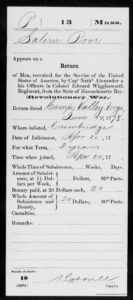Help Wanted: Citizen Transcribers
The 250th anniversary of American independence from Great Britain is approaching in 2026. The National Park Service and the National Archives and Record Administration are calling for volunteers to help with a memorial project. These organizations need volunteers to transcribe, or type, millions of handwritten documents from Revolutionary War veterans and their families. This is known as the Revolutionary War Pension Files Transcription Project.
The documents being transcribed relate to surviving soldiers of the Revolutionary War, their widows, or their children who applied for a pension from the United States government. A pension is a set amount of money paid to a person or their descendants following a period of work or service.
The Need for Transcribers
The pension documents are not like official documents used today. Most modern documents can be stored online, searched, and easily viewed. The original pension file documents were handwritten and later scanned onto film. The scanned images, however, are difficult to read. Content cannot be tagged, and online users cannot search the documents. Files are also not organized by family name, making it difficult to read the entire history of a pension application. To create a readable and searchable archive, volunteers must type out the text from the images and upload it into a historical archive, or collection.
Government Pensions
The need for pensions emerged after the Revolutionary War. During the war, soldiers were paid poorly. After soldiers were discharged, there was no money to support their farms or families. In addition, many soldiers were seriously injured. When they returned home, injured soldiers were unable to work to support their families. Veterans and their families became increasingly poverty-stricken.
Beginning in 1818, Congress passed a series of pension acts to help veterans financially. The pension programs covered all who served in the Continental Army or state militias. To receive a pension, a veteran had to submit documents proving he was a soldier during the war.
Who Could Apply
Upon discharge from the Continental Army, soldiers were given official papers. The veteran could submit these when he applied for a pension. When soldiers in state militias were discharged, however, they did not receive paperwork. Militia members had to prove their service by providing written descriptions of places they traveled to and accounts of battles. Soldiers who served in militias even had to supply eyewitnesses to confirm their stories. To apply for their pension, militia soldiers submitted these documents for review.
Widows of veterans could also receive a pension. As proof of marriage and military service, a widow had to provide a marriage license and another form of documentation. Widows often submitted wartime letters or diary entries to show that her husband served. In addition, children of veterans could also receive pensions by offering birth certificates and family Bibles to prove they were descendants of the veteran.
The pension file documents have revealed fascinating pieces of United States history. In one transcribed case from 1837, Judith Lines applied for a widow’s pension. She submitted a letter written by her husband, John Lines, who served under General George Washington. Lines’ letter is the only known preserved letter written by an African American soldier in the Continental Army.
The Scope of the Work

There are 83,000 files in the pension project catalog. Most of the files are 30-40 pages, but some have more than 200 pages. Files with more pages are sometimes the result of a veteran being rejected for a pension. The veteran often reapplied as the restrictions to the program loosened over time. Sometimes, more testimony was needed to prove that the veteran served.
Altogether, there are 2.3 million documents in the catalog that need to be transcribed. Once transcribed, the files will provide a rich history of the Revolutionary War. For Americans and scholars today, these documents are invaluable. They provide a military service record and a vivid and firsthand account of life during the Revolutionary War.
The National Archives has established a web page for any citizen who wants to be a transcriber. People can log in and create their own account and start transcribing. People do not need to have any experience transcribing documents to participate in the project. Training is provided on the website. Visit the National Archives website to learn how you too can help create this Revolutionary War archive: www.archives.gov/citizen-archivist/missions/revolutionary-war-pension-files
